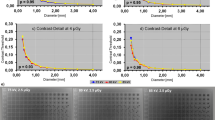Abstract
Purpose
Super-resolution (SR) image processing produces a high-resolution image from a series of low-resolution images. The aim of this study was to evaluate SR-images based on fluoroscopic flat-detector (FD) acquisition at different frame rates.
Methods
Fluoroscopic FD-sequences with 20 frames were obtained with varying pulse frequencies of (1) a line pair resolution phantom; (2) a low-contrast resolution phantom, and (3) a human knee specimen. Super-resolution digital radiographs (SR-Radiographs) were generated from each sequence. Variable-dose images were simulated by constructing SR-Radiographs using 6 and 12 frames from the corresponding fluoroscopic sequence. “Single Shot” and Computed Radiography (CR) images were obtained for comparison based on dynamic range and sharpness of bone detail structures. Patient-derived SR-Radiographic images were constructed to demonstrate clinical examples.
Results
The spatial resolution of SR-radiographs obtained at 12.5 frames per second (fps) and 6 fps were comparable with CR and “Single Shot” images, providing ~3.5 line pairs per mm (l p/mm). Similarly, low-contrast resolution of SR-radiographs obtained at 12.5, 6, and 30 fps were equivalent to CR and “Single Shot” images. The human knee specimen SR-radiograph obtained using 12 FD images at 12.5 fps was superior to a CR image in overall image quality, with a dose reduction of 75%. Variable-dose SR-radiographic simulations suggest a dose saving potential of 90–95% when using 6 FD images at 12.5 fps or 6 fps, respectively.
Conclusions
The phantom testing images and simulation results demonstrate that diagnostic quality SR-radiographic images of skeletal extremities can be synthesized using a flat-panel detector system designed primarily for angiography. SR-images obtained with substantially reduced radiation dose are feasible, and this technology may improve digital radiography for pediatric, neonatal radiography, or mammography applications. Further testing is needed to validate super-resolution techniques in other body regions and for different flat-detector systems.
Similar content being viewed by others
References
Valentin J (2004) Managing patient dose in digital radiology: guest editorial, preface, main points, glossary and chapter 1. Ann ICRP 34: 1–73
Berrington de González A, Mahesh M, Kim KP, Bhargavan M, Lewis R, Mettler F, Land C (2009) Projected cancer risks from computed tomographic scans performed in the united states in 2007. Arch Intern Med 169(22): 2044
Berliner LF (2001) United States Patent 6,278,765 entitled Process for producing diagnostic quality x-ray images from a fluoroscopic sequence. http://patft.uspto.gov/netacgi/nph-Parser?Sect1=PTO2&Sect2=HITOFF&p=1&u=/netahtml/PTO/search-bool.html&r=3&f=G&l=50&co1=AND&d=PTXT&s1=berliner&s2=fluoroscopic&OS=berliner+AND+fluoroscopic&RS=berliner+AND+fluoroscopic
Bernhardt P, Lendl M, Deinzer F (2006) New technologies to reduce pediatric radiation doses. Pediatr Radiol 36(Suppl 2): 212–215
Robinson D, Farsiu S, Lo JY, Milanfar P, Toth CA (2007) Efficient multiframe registration of aliased X-Ray images. In: Proceedings of the 41st Asilomar Conference on Signals, Systems, and Computers. Pacific Grove, CA. http://www.duke.edu/~sf59/Asilomarv_2007.pdf. Accessed on line 8 June 2010
Berliner L (2010) Super-resolution applications in digital radiography. Poster Presentation at SIIM 2010. Minneapolis, Minn. http://www.siim2010.org/abstracts/PD_Berliner.html. Accessed 13 June 2010
ImageJ. http://rsb.info.nih.gov/ij/
StackReg plug-in for ImageJ may be accessed at Biomedical Imaging Group, Swiss Federal Institute of Technology Lausanne. Ecole Polytechnique Federale de Lausanne. http://bigwww.epfl.ch/thevenaz/stackreg/. Accessed 4 July 2010
Thévenaz P, Ruttimann UE, Unser M (1998) A pyramid approach to subpixel registration based on intensity. IEEE Trans Image Process 7(1): 27–41
AGFA MUSICA 2 White paper http://agfabeint01.net.agfa.com/bu/mi/Mednet/MedNet.nsf/AllDocs/90AD66093B67980EC125726F0032EE37/FILE/White%20Paper%20MUSICA2%203.0.pdf. Accessed 17 July 2010
Bannore V (2009) Iterative-interpolation super-resolution image reconstruction: a computationally efficient technique in studies in computational intelligence, vol 195. Springer, Berlin, pp 1–8
Chaudhuri S (2002) Super-resolution imaging. Kluwer Academic Publishers, New York, pp 1–20
Park SC, Park MK, Kang MG (2003) Super-resolution image reconstruction: a technical overview. IEEE Signal Process Mag 20: 21–36
Pham TQ (2006) Spatiotonal adaptivity in super-resolution of undersampled image sequences. Ph.D. Thesis, Quantitative Imaging Group, Delft University of Technology
Hunt BR (1995) Super-resolution of images : algorithms, principles and performance. Int J Imaging Syst Technol 6: 297–304
Lin Z, Shum HY (2004) Fundamental limits of reconstruction-based superresolution algorithms under local translation. IEEE Trans Pattern Anal Mach Intell 26: 1–15
Berry R, Burnell J (2006) The handbook of astronomical image processing, 2nd edn. Willmann-Bell Inc, Richmond, p 40
Maths - Affine Transformations. http://www.euclideanspace.com/maths/geometry/affine/. Accessed 13 Aug 2010
ACR Practice Guideline for Digital Radiography (2007) http://www.acr.org/secondarymainmenucategories/quality_safety/guidelines/dx/digital_radiography.aspx. Accessed 4 July 2010.
Pixium 4700: Digital Detector for real-time X-ray Imaging. http://www.trixell.com/pdf/Pixium4700.pdf. Accessed 4 Sep 2010
Wirth S, Treitl M, Reiser MF, Korner M (2009) Imaging performance with different doses in skeletal radiography: comparison of a needle-structured and a conventional storage phosphor system with a flat-panel detector. Radiology 250: 152–160
Author information
Authors and Affiliations
Corresponding author
Electronic Supplementary Material
The Below are the Electronic Supplementary Material.
Rights and permissions
About this article
Cite this article
Berliner, L., Buffa, A. Super-resolution variable-dose imaging in digital radiography: quality and dose reduction with a fluoroscopic flat-panel detector. Int J CARS 6, 663–673 (2011). https://doi.org/10.1007/s11548-011-0545-9
Received:
Accepted:
Published:
Issue Date:
DOI: https://doi.org/10.1007/s11548-011-0545-9




